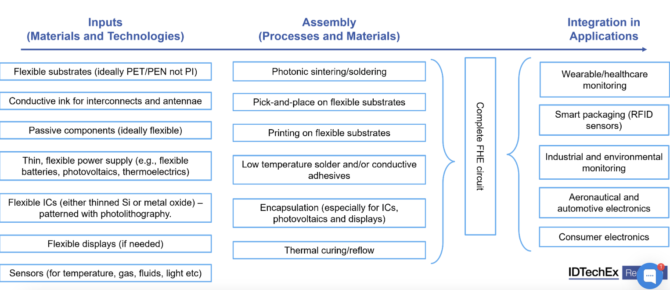
Flexible hybrid electronics delivers enticing blend of capabilities
By Dr Matthew Dyson, principal technology analyst, IDTechEx - Cambridge, UK
Electronics Printable ElectronicsEmerging tech offers the best of both approaches, says IDTechEx
Can electronics be additively manufactured and flexible without compromising on the capabilities of conventionally produced integrated circuits (ICs)? Often described as ‘print what you can, place what you can’t’, flexible hybrid electronics (FHE) offers an enticing blend of capabilities, enabling rapid prototyping, flexibility/stretchability, and roll-to-roll manufacturing of circuits with conventional ICs. Furthermore, this manufacturing methodology is moving out of research labs and into commercial production, with new and existing contract manufacturers now offering FHE.
A recent IDTechEx report on flexible/hybrid electronics (FHE) evaluates the status and prospects of FHE circuits, which is forecast to reach a market size of around US$1.8 billion by 2034 – more if the associated infrastructure, software and services are included. Granular market forecasts break down the opportunities for FHE circuits across five application sectors (automotive, consumer goods, energy, healthcare/wellness, and infrastructure/buildings/industrial) into 39 specific opportunities, such as skin temperature sensors and printed RFID tags.

Inputs, assembly, and applications for FHE circuits. Source: IDTechEx
Enabling technologies
Manufacturing FHE circuits requires many current and developing emerging technologies that are essential to circuits. These include:
- Low-cost thermally stabilized PET substrates that are dimensionally stable
- Component attachment materials compatible with flexible thermally fragile substrates, such as low-temperature solder and field-aligned anisotropic conductive adhesives
- Flexible integrated circuits based on both thinned Si and metal oxides
- Conductive inks based on both silver and copper
- Thin film batteries, especially if printable
- Printed sensors of all types
- Manufacturing methods for mounting components on flexible substrates
Assessing application opportunities
With so many potential addressable markets, establishing where FHE offers the most compelling value proposition relative to alternative electronics manufacturing approaches is essential. As a manufacturing methodology rather than a specific product, the benefits of using FHE are highly dependent on the application.
For prototyping and high mix low volume production, printing with digital methods such as inkjet rather than chemically etching the conductive traces enables straightforward adjustments to design parameters. This brings multiple benefits, including shortening the product development process by reducing the time between design iterations and facilitating product ‘versioning’ to meet specific customer requirements without substantially increasing production costs.
Conformality is enabled by stretchability
Alternatively, for very high-volume applications such as RFID tags, smart packaging, and even large-area lighting, the compatibility of FHE with high throughput roll-to-roll (R2R) manufacturing via rotary printing methods such as flexography and gravure offer the potential for reduced costs. Rapid production can be expedited by low-temperature and/or high-speed component attachment methods, with competing approaches.
Flexibility and stretchability, of course, also form part of FHE’s value proposition. While conventionally manufactured flexible pcbs already meet some application requirements, such as for making electrical connections in confined spaces, the resilience of many printed conductive inks to repeated bending and tighter curvatures offers a clear differentiator. FHE is thus well suited for wearable applications such as electronic skin patches and applications where conformality is enabled by stretchability, such as integrated lighting.
———-
Matthew Dyson is a Principal Technology Analyst at IDTechEx, specializing in printed/organic/flexible/hybrid electronics and sensors. Matthew analyses technical innovations and applications across the printed/organic/flexible/hybrid landscape, publishing his analysis on the IDTechEx portal and in reports.

